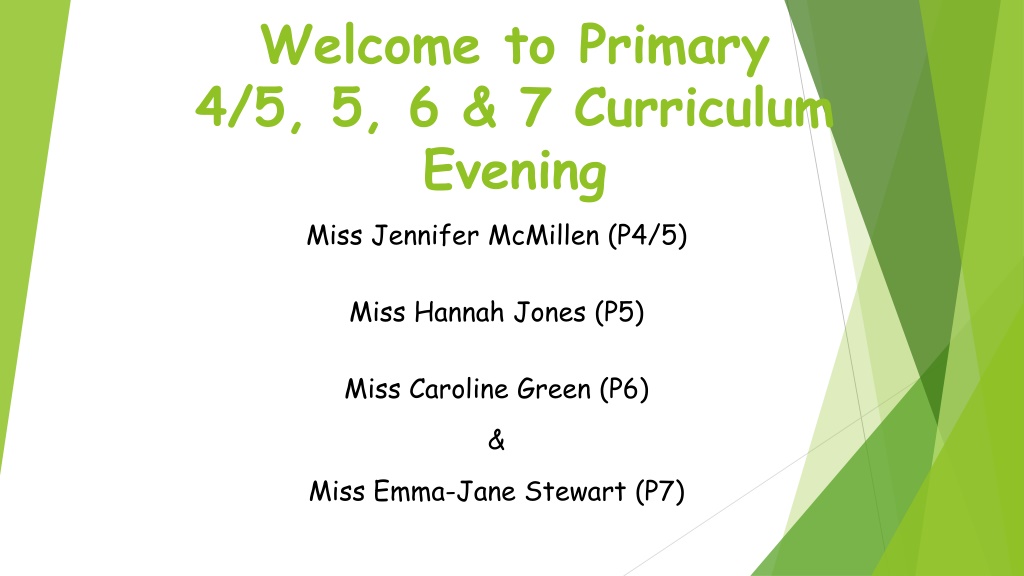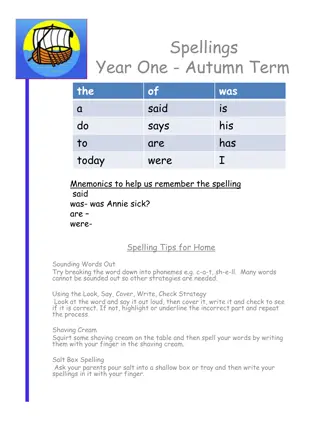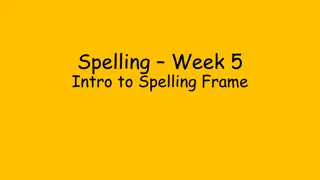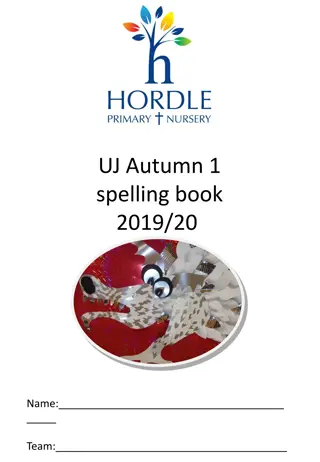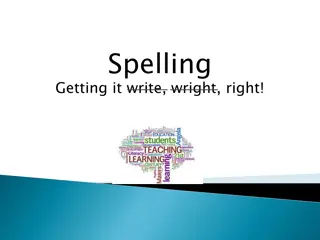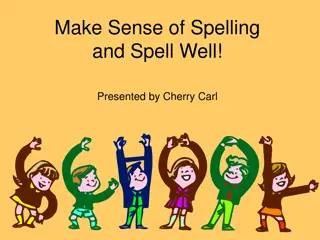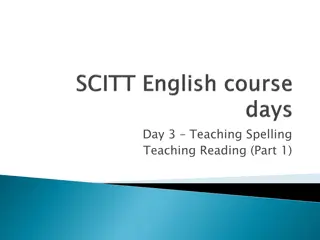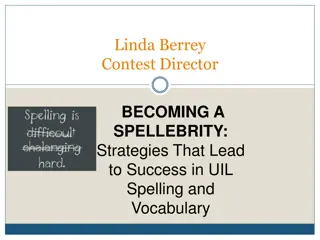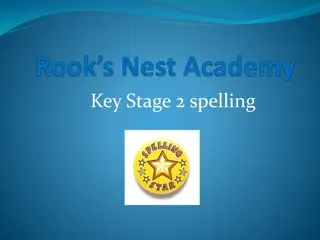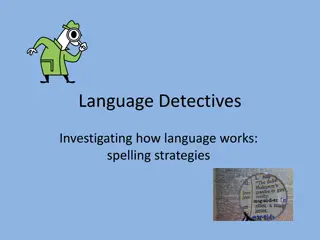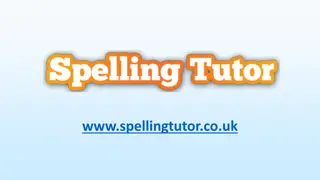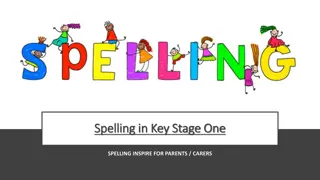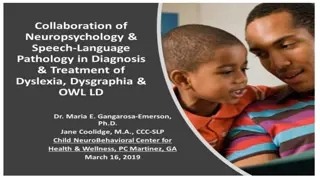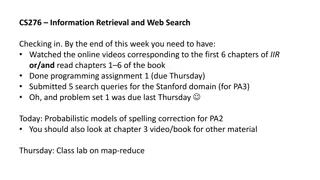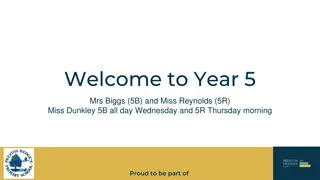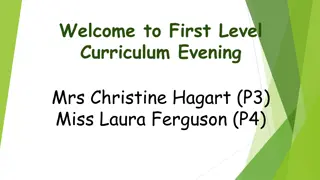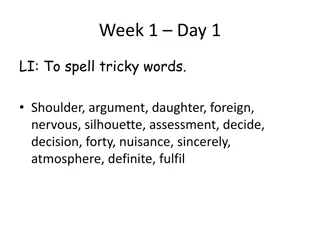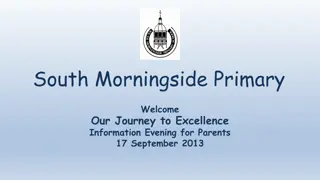Primary 4-7 Curriculum Evening Overview and Spelling Policy Update
Explore the curriculum evening details for Primary 4/5, 5, 6, and 7 with insights on the revised spelling policy, numeracy strategies, health and wellbeing, and online learning. Discover the school's vision for enhancing learners' spelling abilities through differentiated approaches. Learn about the multi-sensory teaching strategies and see an example of a spelling sound list in P5. Stay informed about the progressive spelling program and how students engage in practicing spelling patterns weekly.
Download Presentation

Please find below an Image/Link to download the presentation.
The content on the website is provided AS IS for your information and personal use only. It may not be sold, licensed, or shared on other websites without obtaining consent from the author. Download presentation by click this link. If you encounter any issues during the download, it is possible that the publisher has removed the file from their server.
E N D
Presentation Transcript
Welcome to Primary 4/5, 5, 6 & 7 Curriculum Evening Miss Jennifer McMillen (P4/5) Miss Hannah Jones (P5) Miss Caroline Green (P6) & Miss Emma-Jane Stewart (P7)
Curriculum Evening Overview Learning Across the Curriculum Termly Newsletter Literacy - Revised Spelling Policy Numeracy - Mental Agility Assessment Strategies Across the Curriculum Health and Wellbeing Online Learning Journals Revised Homework Policy
Our School Spelling Policy 2017- Key Messages Our Vision Spelling is integral to a learner s self esteem and ability to communicate in writing. Through our differentiated and motivating approach to the teaching of spelling all learners will be given the opportunity to make progress with their spelling and be able to communicate their needs and ideas confidently in writing.
What will this look like? Primary 4 7 will follow our new school progressive spelling programme. On a Monday the teacher will introduce the sound for the week. The children will have a differentiated spelling list but they will all learn the same spelling pattern. On a Tuesday, Wednesday, Thursday they will have the opportunity to practice the spelling pattern using multi- sensory teaching strategies. (see slide) On a Friday the children will practice common words and revise previous sound rules.
What are multi-sensory teaching strategies? Say TTYP flashcards guess which mnemonics rhyme say/ sing syllables word tennis Write Make/Do tallying word clapping partner L,C,S,W,Ch find words within words noughts and crosses model/make word with materials matching games finger spelling magnetic boards typing cutting stamp it out dictionary hunt spelling aerobics (Using cursive script) rainbow spelling hi-light spelling pattern from a text alphabetize your spelling list word search word muddling spelling shapes/ pictures friends and enemies tracing back writing air writing dictation hangman
Example of spelling sound list in P5 Weekly Focus:- ou for /u/ Group 1 country couple cousin double famous touch trouble young Group 2 courage enormous enough nervous nourish rough tough youngest Group 3 courageous dangerous encourage fabulous flourish generous marvelous roughest
How will we assess and track that your child is making progress? Ongoing look, cover, sound out, write check/self assessment/ peer assessment/teacher assessment of application of spelling patterns in pupil writing in class Twice a term summative test of sounds covered that term. This test will take place in their home school learning journal so that you can see evidence of progress. We will be testing ability to apply the sounds learnt NOT whether your child has learnt the spelling list for each sound. Annually all pupils will be tested using the singe word spelling test to track progress and identify pupils who would benefit from programmes of support.
Stockbridge Counts Stockbridge Counts will focus on daily 10 to 15 minute mental agility at the start of every maths lesson. The whole school will focus on each aspect at the same time.
Stockbridge Counts A Rainbow of Numeracy Skills Counting forwards and backwards Number recognition Number after and before Combining and partitioning numbers & place value Sequencing and ordering; number lines; equivalences Multiplication and division; fractions, decimal fractions and percentages; ratio and proportion Addition and subtraction
Skills Area What this might look like for your child - In stations of all times tables up to 12 - In fractions, decimal fractions and percentages - In negative numbers Counting forwards and backwards
Addition and Subtraction Why Mental Agility Counts? 45+2 35+36 37 + 39 123+261 Addition methods Counting on to add Doubles and near doubles Rounding and adjusting Add ten take off one Partitioning tens and units Quick, real life skill, preparation for high school for multi-step problems, challenge Formal methods (chimney sums)
Empty Number Lines Multiplication Time Duration Addition and Subtraction Change from Money
Formal Methods for Multiplication and Division. Grid Method Chunking Formal Method
Times Tables and Number Bonds By the end of P5 all times tables and associated division facts from 2-12 should be recalled accurately with minimal thinking time and used to solve problems. Some children will require support aids to assist them with this. Children working within Second Level should be able to recall number bonds to 100. They should be able to use associated facts to help them with more complex calculations.
Assessment Strategies Across the Curriculum Why use a range of strategies? Peer Assessment What will this look like? Self Assessment What will this look like? Verbal Assessment What will this look like?
Health and Wellbeing Mental and Emotional Wellbeing Building Resilience Programme (Whole school focus outlined in newsletter) Substance Misuse P5 Tobacco P6 Alcohol P7 Drugs
Online Learning Journals We are using these to provide informative and up to date information and assessment on your child and their learning. We greatly appreciate parental comments
Home School Learning Policy Key Messages WHAT IS THE PURPOSE OF HOME LEARNING? To consolidate and reinforce learning. To promote home/school partnerships and provide opportunities for parents and children to work together. To promote the value and enjoyment of life long learning. To develop independent learning skills and encourage good learning habits. To provide an opportunity for parents to gain an understanding of what and how children are learning at school. To provide tasks which build on the children s skills and interests. We acknowledge that different family circumstances provide different amounts of time for families to learn together. This policy was created in response to parent feedback (school survey May 2017) that our home learning policy should be flexible and provide activities that support parents with ideas for home learning without being prescriptive.
Home School Learning in P4-7 A home learning wall will be sent home each term. Spelling pattern and word lists will be given to parents on curriculum evening and are published on the school website. Spelling tasks will be included in the home learning wall. All children will be asked to complete a long term project linked to a topic in class twice a year. They will be given a deadline for completion and the sharing of this learning. All home learning journals should be brought into school on a MONDAY.
Minimum expectations in P4-7 We expect parents to encourage their child to read for enjoyment as often as possible. We expect pupils to complete at least one task from the home learning wall each week (please note that in P6/7 encouraging positive engagement with home learning is particularly useful in developing the independent learning skills which are necessary for transition to high school). Where the home learning task is a talking task or a game we ask that the pupil records evidence such as a short personal comment/reflection, or takes a photo, draws a picture or records a comment from the parent in the home learning journal. We expect pupils to complete two long term projects each year.
How will my child receive feedback? The purpose of home learning is to consolidate skills and develop independent learning skills and as such we do not expect staff to give detailed written feedback. Feedback strategies for pupils will include Discussion with pupil individually Short written feedback Pupils will share their work with a peer and give peer feedback Pupils will self-assess Group discussion Pupils may share learning with the class and get immediate verbal feedback such as 2 stars and a wish. A spelling challenge will take place throughout the school once every half term to monitor progress (P3-7). This will take place in the back of the home learning journal to allow you to see the progress made and any areas for development. More detailed feedback will be given on long term project related home learning tasks and this will be stuck into home school learning journals or recorded on the Online Learning Journals.
Thank you for listening! Please feel free to browse the maths and literacy resources at the back of the room and ask any questions.
